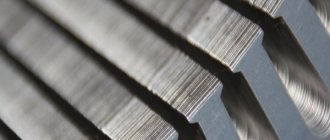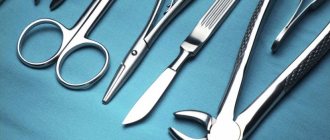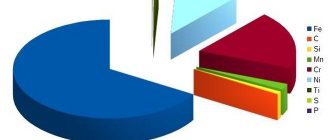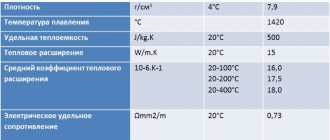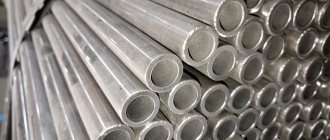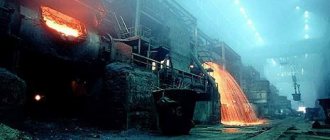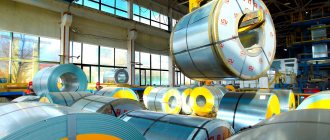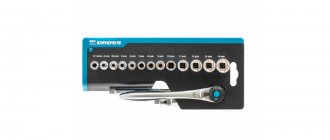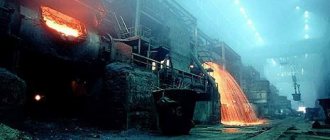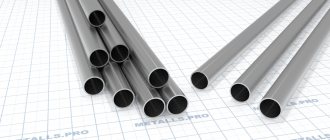Structural carbon or high-carbon steel includes spring steel. To give it highly targeted properties, it is doped in small quantities with 2-3 elements, for a total of up to 2.5%. But the use of these steel grades is not limited to the manufacture of springs. This group is called that because the name most strongly reflects their main feature - elasticity.
Areas of use
Spring steel is a low alloy alloy
Spring steel is used to make a wide range of products and parts used in vehicles, machinery and plant equipment. Torsion bars and springs, which can be found in suspensions of cars and armored vehicles, are made of steel grades 55C2, 60C2A and 70C3A. Recently, 50HFA steel has been used for the same purposes. Valves for springs are usually made from it.
Vehicle parts are not the only area where spring steel is used. Materials from this category are used for the manufacture of master keys, springs for friction discs, as well as for various types of mechanisms, including industrial ones. Certain grades of steel are suitable for certain products and springs. There are big differences between them in terms of important performance characteristics:
Examples of application of structural alloy steels
- 50HGFA – used to create clock springs;
- 55C2 – springs and leaf springs used in vehicle suspension;
- 60G, 65 – for the manufacture of wear-resistant and vibration-resistant springs, thrust washers;
- KT-2 – for rolling cold-rolled wire.
There are numerous other brands, many of which can be used interchangeably. For example, steel grade 68 can be used instead of 65GA, and steel grade 70(G) perfectly replaces 60G. In GOST you can find tables that list all existing brands with their processing modes and properties.
Composition and production
To assemble springs and mechanisms based on them, steel is used, which contains from 0.5% to 0.75% carbon. If the content of this element exceeds 0.7%, the material is called tool steel. It is a hard and highly durable material for making various tools. It is also used to create springs that are as resistant to mechanical stress as possible.
Carbon is not the only element that influences the important properties of spring steel. During the production of metal, alloying components are deliberately introduced into its composition in the following concentrations:
Carbon
- nickel – up to 1.7%;
- tungsten – up to 1.2%;
- chromium – up to 1.2%;
- vanadium – up to 0.25%;
- manganese – up to 1.25%;
- silicon – up to 2.8%.
The most important stage of the production process is grain grinding. As a result, the resistance of the finished metal to small plastic deformations increases significantly. This has a positive effect on the relaxation resistance of springs, which are made from high-alloy steels.
Modern methods of manufacturing alloys for creating springs make it possible to produce materials with any design, any surface and diameter, when it comes to spring wire. Both domestic and international standards defining the performance characteristics of steel are strictly observed. In addition, careful quality control is carried out at each stage of creating spring alloys.
Heat treatment
There are several heat treatment modes for this type of steel. Any of them is selected in accordance with the production requirements for the finished product. Most often, two heat treatment methods are used, which guarantee the required properties from a chemical and physical point of view. These methods include normalization and hardening followed by tempering.
When carrying out heat treatment, it is necessary to correctly select the temperature parameters, as well as the time needed to carry out the operation. To choose these characteristics correctly, you should start from what grade of steel is used. Since the material of grade 65G belongs to the hypoeutectide type, this product contains austenite, presented in the form of a solid mechanical mixture with a small amount of ferrite. Austenite is a harder material in terms of structure than ferrite. Therefore, to carry out heat treatment of 65G steel, it is necessary to create a lower quenching temperature range. Taking this fact into account, similar indicators for this type of metal range from 800 to 830 degrees Celsius.
Marking
The marking of steel for the production of spring products is quite simple, but at the same time informative. By the designation you can understand the composition of the material, which determines all its operational properties. The marking is deciphered in the direction from left to right. It includes the following items:
Steel marking
- the first position of two digits expresses the mass of carbon in hundredths of a percent;
- the second position of one or more letters indicates the name of the alloying element;
- the third position shows the fraction of the alloying element rounded to the nearest whole value.
If the share of the alloying element in the metal is less than 1.5%, it is not indicated in the marking. By the designation you can easily understand what type of metal it belongs to. For example, spring steel grades 65, 70, 75, 80 and 85 are classified as carbon. Materials whose markings contain at least two positions are classified as alloyed, since they contain a high concentration of alloying elements.
Characteristics
The main properties of materials for the manufacture of steel brake bands, springs and other products are high fluidity and elasticity. A significant increase in elasticity is achieved by hardening the alloy in oil at high temperatures in the range from +820 °C to +870 °C. After hardening, tempering must be carried out in the temperature range from +400 °C to +480 °C. If there is a need to increase such properties of the metal as strength, toughness and ductility, production resorts to isothermal hardening.
Based on the characteristics of the material for creating springs, the following groups of metals are distinguished:
Table of calculated steel resistance values
- by chemical composition - ordinary, stainless, alloyed metal;
- by processing method - calibrated, hot-rolled, forged steel, with special finishing.
Metals used to make springs must be checked and standardized according to their chemical composition. In this case, rental is classified into categories. There are a total of 14 categories, which are designated by markings from 1 to 4B inclusive. For some characteristics, standardization is not performed. For example, metals of categories 1, 1A, 1B are not standardized for the presence of a decarbonized layer and hardenability.
Application [ edit | edit code ]
It is used for the manufacture of springs and similar products, for example, torsion bars and leaf springs. Due to its resistance to breaks and cracks, spring steel is also widely used in the production of metal swords for stage battles. Spring steel is one of the most popular materials for making picks due to its elasticity and flexibility. Also used for piano strings and spring clamps.
NEWS
It became possible to manufacture springs from wire of square and rectangular sections; conical and barrel springs
PROSPECTS
In 2015-2018, further development of the main production is planned: -Construction of additional areas for the main production. -Purchase, for the purpose of updating, of new high-performance winding equipment.
useful links
Quality and technology
Steel for making springs
Steel is an alloy of iron and carbon, in which the carbon content does not exceed 2%. Steel is produced primarily from a mixture of pig iron smelted in blast furnaces and scrap steel. Steel has high mechanical and good technological properties, so it can be forged, rolled, cut, and heat treated. Many grades of steel are cold processed.
The most harmful impurities that degrade the quality of steel are sulfur and phosphorus. Sulfur imparts embrittlement to steel at high temperatures (red brittleness), and phosphorus at low temperatures (cold brittleness). The quality of steel is deteriorated by non-metallic inclusions and dissolved gases contained in it in varying quantities, depending on the production method.
According to the production method, steel is divided into open-hearth steel (basic and acid), converter steel and electric steel. Steel production in open-hearth furnaces can be carried out using a scrap process, in which the charge includes metal scrap and pig iron. In open-hearth furnaces, various combustible gases, as well as fuel oil and oil, are used as fuel.
As a result of the chemical reactions occurring during smelting, the content of harmful impurities - sulfur and phosphorus - is reduced, and to obtain the required steel composition, alloying elements are introduced in the form of ferroalloys and “pure metals”.
Acid open hearth steel, compared to basic steel, contains a smaller amount of dissolved alloys and harmful non-metallic inclusions and has higher mechanical and technological properties. Currently, the open-hearth method produces the largest amount of steel - high-quality carbon structural and tool steel, as well as low- and medium-alloy steel, widely used in mechanical engineering.
The essence of the converter method of steel production is that air enriched with oxygen is blown through liquid cast iron poured into a converter (pear-shaped vessel), resulting in the combustion of carbon and other impurities. The content of sulfur and phosphorus in this steel is lower than in open-hearth steel. The purging process lasts 15-20 minutes. This method of steel production is becoming increasingly used.
Electric furnaces (arc or induction) produce the highest quality steel. Compared to other smelting methods, steel smelted in microfurnaces has the highest purity of sulfur and phosphorus, contains the least amount of gases and non-metallic inclusions, and is used for the manufacture of the most critical machine parts operating under difficult conditions (under high loads, pressures, etc.). etc.), and also for cutting tools, the cheapest in cost is converter steel and the most expensive is electric steel.
Based on their chemical composition, steels are divided into carbon and alloy. Carbon steels are divided into low-carbon with a carbon content of up to 0.25%, medium-carbon with a carbon content of 0.25 to 0.6% and high-carbon with a carbon content of 0.6 to 2.0%.
Alloyed steels are divided into low-alloyed, in which the total content of alloying components is less than 2.5%, medium-alloyed, with an alloying component content of 2.5 to 10%, and high-alloyed, with an alloying component content of more than 10% (in alloyed steels, carbon is not considered an alloying element).
Read also: Current limitation on lm317
According to their purpose, steels are divided into structural (carbon and alloy), intended for the manufacture of various structures and machine parts, including springs, springs, ball bearings, etc., tool steel - carbon, alloy, stamping, high-speed, used for the manufacture of cutting and measuring tools, dies for cold and hot forming, and steel with special physical properties.
The starting materials for the manufacture of springs are special high-quality (spring) steels and non-ferrous alloys. The mechanical properties of heat-treated high-quality spring steel and the chemical composition are given in GOST 14959-69.
The most commonly used springs are carbon spring steels 65 and 70, silicon steels 55C2 and 60C2, as well as manganese steel. Manganese steel is very resistant to decarburization when heated. If overheated, manganese steel cracks during hardening and acquires brittle properties. Silicon steels are easily calcined; overheating does not lead to the disadvantages characteristic of manganese steel.
For the manufacture of springs, alloy steels are used: chromium-manganese, chromium-silicon, chromium-vanadium, chromium-silicon-vanadium, tungsten-silicon and nickel-silicon.
Alloy steels have high strength properties and are easily calcined; springs made of these steels work for a long time. These steels are used for the manufacture of especially critical springs operating in unfavorable atmospheric and temperature conditions. Twisted springs are made from steel and non-ferrous rolled products of round, square, rectangular and other profiles. Spring wire for the manufacture of small and medium springs is supplied in coils.
Flat springs are made from tape, strip and sheet of high-quality steel and non-ferrous rolled products.
The assortment for hot-rolled spring steel (GOST 7419-74) must comply with the grades and technical requirements (GOST 14959-69). Steel is supplied in round section from 5 to 50 mm inclusive and square section with a square side from 6 to 50 mm inclusive. Dimensions and permissible deviations for round steel are provided for by GOST 2590-71, for square steel - GOST 2591-71.
Spring strip steel of rectangular section with slightly blunted corners (type A) is supplied in widths from 20 to 160 mm inclusive, thickness from I to 18 mm inclusive. The dimensions of the strips and permissible deviations in thickness and width are provided for by GOST 103-76. It is allowed to supply strips with a thickness of .'i mm, a width of 30; 35; 40; 45 and 50 mm with permissible thickness deviations ±0.3 mm. Spring steel is also available as type B (with rounded edges). Steel is subjected to special rolling for the manufacture of locomotive, thermal and carriage springs.
Steel spring tape is divided into fi categories based on strength: first (1P), second (2P) and third (ZP). In terms of accuracy, the tape is also produced in three categories: normal (N), increased (P) and high (H).
For the manufacture of small and medium-sized springs, the industry supplies steel carbon spring wire in accordance with GOST 9389-75, which is divided into classes: I - high strength, II - increased strength, III - normal strength.
Wire of classes I and III is divided into two groups according to ductility (I and II), wire of class II is divided into groups (I, II and III).
Cold-drawn carbon steel wire for valve springs for critical purposes is manufactured in the following diameters: 2.0; 2.3; 2.5; 2.8; 3.0; 1.0; 4.5; 5.0; 5.5; 5.7 and 6.0 mm; steel spring heat-treated wire for critical purposes in accordance with GOST 1071-67 is produced with a diameter of 1.2; 1.4; 1.6; 1.8; 2.0; 2.3; 2.5; 2.75; 3.0; 3.4; 3.5; 3.6; 3.75; 4.0; 4.1; 4.2; 4.5; 4.8; 5.0 and 5.5 mm.
Alloyed spring steel wire in accordance with GOST 14963-69 is manufactured with a diameter of 3 to 12 mm every 0.5 mm.
Chrome vanadium steel wire for springs in accordance with GOST 14963-69 is manufactured in the following diameters: 0.5; 0.8; 1.0; 1.2; 1.4; 1.6; 1.8; 2.0; 2.2; 2.5; 2.8; 3.0; 3.2; 3.5; 3.8; 4.0; 4.2; 4.5; 4.8; 5.0; 5.5; 6.0; 6.5; 7.0; 7.5; 8.0; 8.5; 9.0; 9.5; 10; eleven; 12; 13 and 14 mm.
The process of manufacturing high-quality spring wire is very labor-intensive and is carried out at specialized metallurgical plants. The process begins with the processing of a workpiece called wire rod, which has a diameter of about 6 mm. The workpiece is processed on drawing mills with intermediate heat treatment and pickling.
The technological process for manufacturing wire with a diameter of 1.5 mm from U9A steel proceeds as follows. A wire rod with a diameter of 6 mm, passing through a thermal furnace at a speed of 1.5-2.0 m/min, is heated to a temperature of 900-950 ° C and cooled in air. This processing is called normalization. After this, etching is carried out in a 10% solution of sulfuric acid in water at a temperature not exceeding 40-50 ° C, washing in cold water, copper plating in a solution of copper sulfate, a second washing in cold water, liming and drying in a drying oven at a temperature of about 100° C. Then, on the mill, drawing is carried out sequentially through three dies from a diameter of 6 mm to a diameter of 4 mm. In this case, a work hardening is formed on the surface of the workpiece, which is eliminated by patenting. Patenting involves heating a wire moving at a speed of up to 3.5 m/min in muffle furnaces to 900–950° C, followed by passing it through a lead bath at a temperature of 500–550° C.
Read also: How to restore nickel-cadmium batteries for screwdrivers
Then re-etching, washing, copper plating, washing again, liming and drying are carried out.
The workpiece undergoes final drawing on a mill from a diameter of 4 mm to a diameter of 1.5 mm through 14-15 dies. The overall degree of compression is 85-90%.
Thermal operations at the transitions during wire drawing and strict adherence to the acid pickling process are decisive for ensuring high quality spring wire.
When winding springs, very serious importance is attached to the condition of the wire surface, which will affect the quality and reliability of the springs. The surface of the wire must be smooth without longitudinal and transverse strokes, cracks, burrs, rust, hairlines, sunsets, film and other external defects visible to the naked eye.
During heat treatment, the surface of the wire and on the wound springs is subjected to decarburization, and the deeper the decarburization of the wire, the sharper the elastic properties of the springs. The permissible depth of the decarburized layer and the degree of decarburization of springs and spring wire are established by technical conditions.
Carbon wire of small sections is usually manufactured with a copper-plated surface, the layer thickness of which varies. Under the copper-plated layer, various defects are covered, which can lead to defective springs. The copper-plated layer does not have a strong adhesion to the base metal and, when drawn, acts as a lubricant. It is not recommended to apply protective coatings to springs made of such wire without preliminary degreasing, etching and other operations that help obtain a high-quality surface of the wire. The surface of the spring is covered with a protective layer to protect against the harmful effects of corrosion. During galvanic coating, hydrogen saturation occurs and the surface of the spring becomes embrittled, therefore, galvanic coatings are not applied to springs made from wire with a diameter of up to 0.3 mm.
For questions regarding placing orders for the production of springs, please contact:
+7(351)200-36-34
| Moscow | Saint Petersburg | Voronezh |
| Ekaterinburg | Novosibirsk | Krasnodar |
| Krasnoyarsk | Nizhny Novgorod | Kazan |
| Tolyatti | Volgograd | Ufa |
| Permian | Rostov-on-Don | Samara |
| Tyumen |
© 2015-2018 Spring and Coiling Plant LLC. Production and sale of metal springs: production of torsion springs, coiling of compression springs, disc springs. We offer pipeline hangers and supports, as well as retaining rings.
Spring steel, grades of which are applicable in the manufacture of tight products, characterized by restoration of the original shape, with strong bending and significant twisting.
The most important parts in the production of mechanisms that experience variable, repeated loads, under the influence of which severe deformation occurs. As soon as the load stops, these elements return to their original shape. There is a feature in the operation of these parts that does not allow residual destruction; it must only be elastic. Excessive production requirements are placed on spring steels. Let's figure out what kind of steel springs are made of?
Primary requirements
The key characteristics of spring products are subject to strict GOST requirements. The main list of technical requirements is regulated by GOST 14959-79. It contains a list of both carbon and alloy steel grades. It also describes the requirements for labeling, packaging, rules for transportation, storage and use of rolled spring steel.
List of some requirements:
GOST 14959-79
- maximum mass fraction of copper – 0.2%, residual nickel content – no more than 0.25%;
- steel grade 51HFA can be used exclusively for the manufacture of elastic wire;
- the maximum mass fraction of sulfur and phosphorus in steel grade 60S2G is no more than 0.06%.
Some spring steel requirements may not be met. For example, the above-mentioned GOST allows changing the concentration of manganese in the alloy composition at the request of the customer. However, this action is permissible only for those spring alloys that do not contain alloying elements such as nickel and chromium. It is also not recommended to deviate too much from the tables that indicate the permissible concentrations of elements.
Why is spring alloy produced?
Both alloy steel and carbon steel can be used to produce parts; they have increased elasticity, toughness, endurance and ductility. Due to the properties of these types of steel, elastic destruction is limited.
Spring steels are affordable, technologically advanced, and have a high limit of relaxation resistance.
Interesting: to obtain high-quality products from carbon and alloy steel, it is hardened at a temperature of 420-520 degrees, which produces the effect of a troostite structure.
Spring steels resist fragile fracture and are characterized by increased ductility. They are used to produce products with high wear resistance, for example:
- clamping collets;
- brake rolling;
- edges;
- springs and leaf springs;
- thrust washers;
- bearing torsos;
- friction discs;
- gears.
Features of steels
Spring steel – a number of grades, in the process of creating which the method of plastic cold deformation is used. To implement this method, shot blasting and waterjet technologies can be used. The specific methods used in the production of spring metals endow the alloy with not only positive, but also negative qualities. The disadvantages of such materials include:
- difficulty of cutting - this process is possible, but processing of finished products is difficult;
- poor weldability - metals for the production of springs are not at all intended for welding.
Steel 60G - spring-spring
Separately, it is necessary to highlight such a type of metal as corrosion-resistant steel. This is a special purpose grade, its main feature is its high resistance to corrosion. In order to provide the material with such characteristics, alloying elements - nickel and chromium - are added to its composition. Nickel content varies from 9 to 12%, and chromium from 13 to 27%, depending on the required properties.
In general, spring metal is in high demand, even despite some disadvantages. The use of such materials is not limited to springs, friction discs and leaf springs. Steel is also used in piano strings, for rolling wire and for other purposes.
Car springs
Car springs work like springs. Their task is to work on bending, and not on tension-compression. Sheets of the product provide rigidity, returning the loaded part to its original state. Springs are a fairly rigid structure, in which additional sheets strengthen the most loaded areas.
This is done to distribute an even load along the entire length of the product, which is extremely important in Russian off-road conditions. Automotive stepladders are used to attach springs to truck axles and improve the rigidity of the entire structure.
Automobile stepladders must meet the design loads in terms of thickness and strength. The material of the product is high-strength steel, which will not break or deform under loads. The carving of the edges of the stepladder and its bends must fully correspond to the car model. When a spring is overloaded, it is destroyed.
Therefore, it is very important to choose the right product for each truck.
